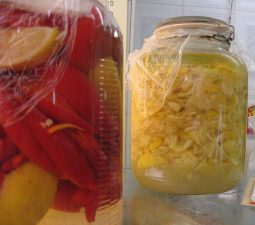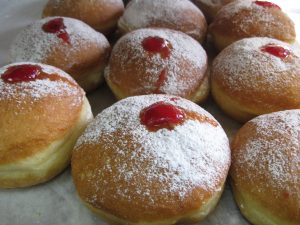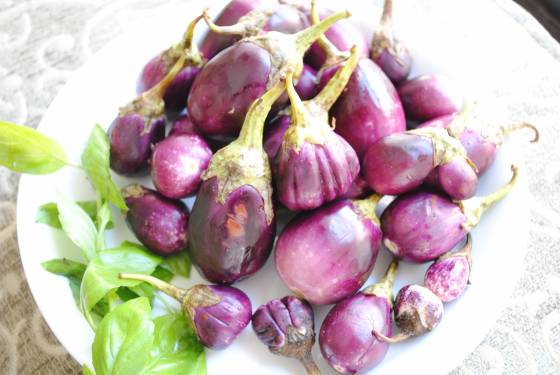 Ever wonder what to do with eggplants? Read on for some Middle Eastern eggplant ideas.
Ever wonder what to do with eggplants? Read on for some Middle Eastern eggplant ideas.
At the start of the month, markets didn’t have much new. Everything in February’s post still applied. Newcomers like strawberries were still expensive and not sweet yet. Now, seasonal produce is on the upward swing towards summer’s abundance and those piles of strawberries fill the air with their fragrance as you move from vendor to vendor in the shuk. Strawberry prices will continue to fall slightly as spring progresses, but if you want to put jam up now, you won’t regret it.
More fruit in season: Avocados must be the best bargain in fruit right now. Black, wrinkly Hass avocados are sold dead ripe and ready for eating right now. Try our natural moisturizing blend with some of these ripe avocados. The larger smooth green varieties are mostly sold hard for ripening at home.
Melons have begun. The smaller varieties are sweet already, but I advise waiting for hotter weather to buy watermelons. Oranges and clementines are still around, but fading out of the picture. Lemons are still abundant and good. Bananas are attractive, with prices slightly lower than at the beginning of the month.
Apples and pears are mostly imported and although attractive, not especially sweet. International shipping and perhaps refrigeration seem to draw the sweetness and flavor out of fruit. However, loquats are out in quantity, and they are a purely local fruit.
Other springtime arrivals are passion fruit, and kiwi fruit, both highly priced. Passion fruit vines grow easily in our climate, with fruit dropping off garden fences onto sidewalks, but kiwi is produced by farmers in the colder hilly regions. Quinces are available and look beautiful, but are most expensive. Papaya fruit has now arrived, although scanty and expensive. Yellow guavas, with their unforgettable heady odor, are another springtime newcomer.
Vegetables: Timeless cooking principle: cook seasonal produce together. Right now eggplants, peppers and tomatoes are fat and glossy, so cooks here naturally grill, then blend them together with garlic and olive oil. It’s a delicious spread with the slightly charred flavor that says Middle East. Or try grilling chunks of vegetables, our way.
Shakshoukah, eggs poached in a tomato sauce with bell peppers, is another brilliant way to combine seasonal vegetables.
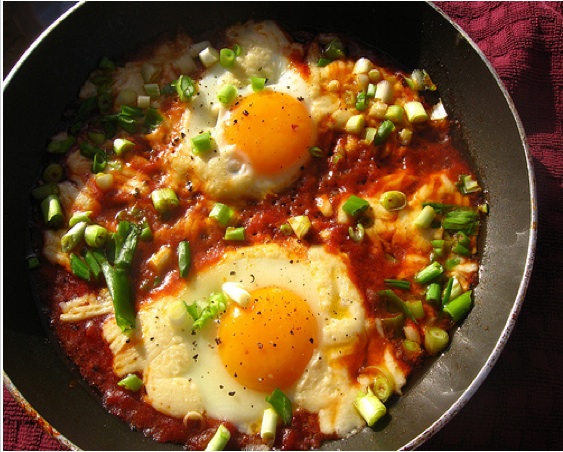
Those prime ingredients for Middle-Eastern chopped salad, cucumbers and tomatoes, are excellent now and prices are coming down as summer approaches.
Bell peppers in all their colors are fat and prime for stuffing, grilling and pickling. Red bell peppers are slightly more expensive than their yellow, orange, and green cousins. Beware peppers imported from Turkey though. Buy organic if you can. Peppers are worth buying for salad or muhamarra spread now, but wait for full summer to buy quantities for pickling.
Eggplants again: both long, slender and full-bodied varieties, are worth buying now. Once the hot weather starts eggplants are the first to spoil and buckle in the heat, so buy now and enjoy.
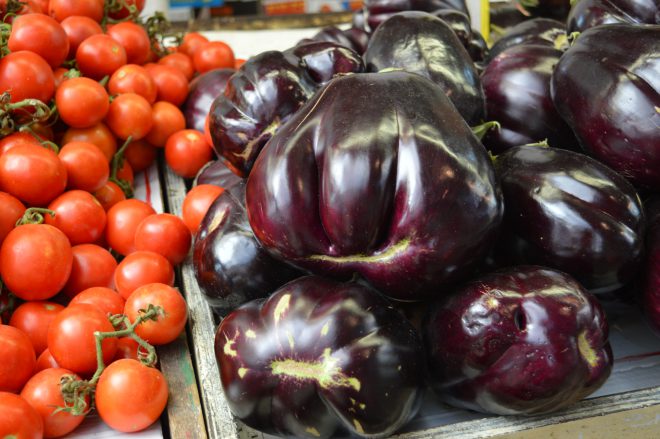
Squash varieties like pumpkins and zucchini are handsome and excellent for light springtime soups.
Green string beans and yellow wax beans are more in evidence although their prices are still on the high side. Artichokes are full and heavy; this is prime season for them.
Red, white, and baby potatoes of both colors are excellent, as always in spring. Onions are improving – you can ignore the sprouty ones that vendors are still trying to get rid of for the fresh new crops.
Short-season vegetables. Peas are in the markets now, as are green fava beans. Cardoons are in the markets. The cardoon, Cynara cardunculus, also called the artichoke thistle, is a thistle in the sunflower family. It is a naturally occurring species that also has many cultivated forms, including the globe artichoke.
Fresh green garlic is here and if you like it, now’s the time to buy for drying or preserving. Two ways to preserve fresh garlic are peeling and freezing it, or burying the cloves or entire cleaned bulbs in olive oil and herbs and baking till soft. This confit of garlic also freezes well. And eggplants yet again: baby eggplants for pickling are available in some markets. Buy now if you like them.
Some cold-weather vegetables are still firm and worth buying: cabbages, kohlrabi, beets, turnips, carrots, celeriac, parsley root.
Leafy vegetables like lettuces, Swiss chard and celery are very good. Broccoli has been looking rather old, but cauliflowers are going strong, fat, and white.
Herbs are so exuberantly beautiful and plentiful that they deserve space all to themselves. Mint, thyme, rosemary, parsley, dill, watercress, aragula, rocket, bitter wormwood for a sprig in tea, coriander leaf, fresh fenugreek leaves, which are favored by the Indian community, a garlicky Persian leaf called” richu,” basil, scallions, leeks, fresh ginger and “shav,” or sour grass for soup. A variety of savory that tastes like za’atar is being sold now.
Forager’s notes: Mulberry trees have put out leaves, good for stuffing or drying and crumbling later for tea. Shepherd’s purse is flowering and getting leggy, but the heart-shaped seed pods make a peppery accent in salads. Wild marigolds and chamomile flowers are very abundant wherever they’re allowed to grow.
Nettles, chickweed and mallows are no longer worth picking. Plantain leaf is especially abundant now because of the recent heavy rains. Fumaria and cleavers are still good. Mandrakes may be seen in cold regions, but beware – the intriguing purple fruit is toxic.
We promised you eggplant ideas, and here they are:
Eggplant with Tahin/Labneh Sauce

